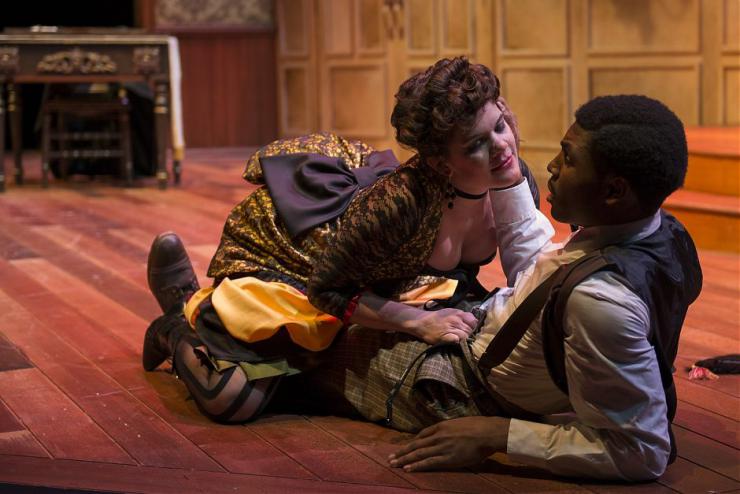This opinion piece by Mike Ross highlights Boston Ballet’s need for their own space and how they (and the arts in general) would benefit from city funding. Here’s a link to the original article, and you can read the text below.
The Bronx wasn’t the only New York City borough where a Boston team was looking to score a victory last weekend. Across town at Lincoln Center, a far more dramatic contest was underway.
In the very theater where George Balanchine, the father of American ballet, led his company to international prestige, Boston Ballet arrived to perform his neo-classical masterpiece “Symphony in Three Movements.” Performing Balanchine at Lincoln Center is the cultural equivalent of challenging Tiger Woods to 18 holes of golf — on his home course.
On Friday night the pressure was on. Two days earlier, a different program by Boston Ballet had been dismissed by New York Times dance critic Alastair Macaulay as “entirely loathsome.” There’s no better way to fire up a room full of Bostonians than having a New Yorker insult your fellow citizens.
And the room was on fire. Personally, I can’t tell the difference between a pirouette or a pas de deux, but I know one thing — this was no “Swan Lake.” The sights and sounds were crisp, modern, and contemporary. It’s the kind of programing that should appeal to a new generation of art goers. And that’s important, because the classic performing arts — opera and symphony, in particular — are seeing a “graying” of their audiences.
But Boston Ballet, now celebrating its 50th anniversary, is young, both literally and figuratively. Among its principal dancers are brother and sister Jeffrey and Lia Cirio, 23 and 27 respectively, who embody that youth. Artistic Director Mikko Nissinen, who told me his vision is to position the company as a ballet for the future, is, at age 52, emerging as an established leader at a time when other American companies are embarking on uncertain transitions in leadership. And just this spring, the company announced its new executive director: Meredith “Max” Hodges, who is 32.
It seems that Boston could one day emerge as America’s favorite ballet company — notwithstanding Macaulay’s dismissal. But despite a strong balance sheet, heroic board leadership, and critical acclaim, there’s something desperately missing for Boston Ballet — a home.
New York City Ballet performs out of the David H. Koch Theatre, which sits within Lincoln Center. It was originally built by the State of New York as a part of the World’s Fair. It was designed specially to house the ballet according to Balanchine’s specifications. More important, the City of New York provides significant capital and operating support for all of Lincoln Center, as well as 32 other cultural institutions. Items like security, maintenance, utilities, and other staffing and building needs are covered not by the institution, but by the city.
Boston Ballet is without these advantages. It’s also an orphan. The company was displaced from its previous venue at the Wang Theater in 2004 by the Radio City Rockettes. Six million dollars later it regrouped where it now performs, at the Opera House on Washington Street — a building it does not own. Its headquarters on Clarendon Street sits on land owned by the Boston Redevelopment Authority. The land is leased not to the ballet, but instead for $1 to the Boston Center for the Arts, a community-based nonprofit, which then charges the ballet $350,000 a year, according to information provided by the ballet. (Disclosure: I first looked into this matter while serving on the Boston City Council.)
That’s a lot of money from an institution that raises nearly half its funds from its donors. The city should negotiate a separate lease with the ballet. But like New York, Boston should also be contributing more toward the arts in general. A sustainable stream of revenue, such as requiring developers to spend 1 percent of their construction budgets for arts, is one way the city could pay for it. But a bold vision for the future of our city and our cultural institutions requires more than money. Boston should look to the outside world for inspiration.
In Sydney, for example, the Opera House has transformed the city, and is one of the most popular attractions in Australia. Boston is booming. Its waterfront is growing. Its skyline is transforming. A multi-venued performance center of an international scale could be a vital part of Boston’s ascent as a global city.
When the Red Sox face the Yankees, they take turns visiting each other’s exquisite ballparks — one very old, the other very new — but both are outstanding places to visit and play. More important, they serve as cash cows that allow the ownership of each to field a competitive team year after year. Like New York, Boston needs home fields for all its teams, cultural and athletic, to compete on equal terms.





